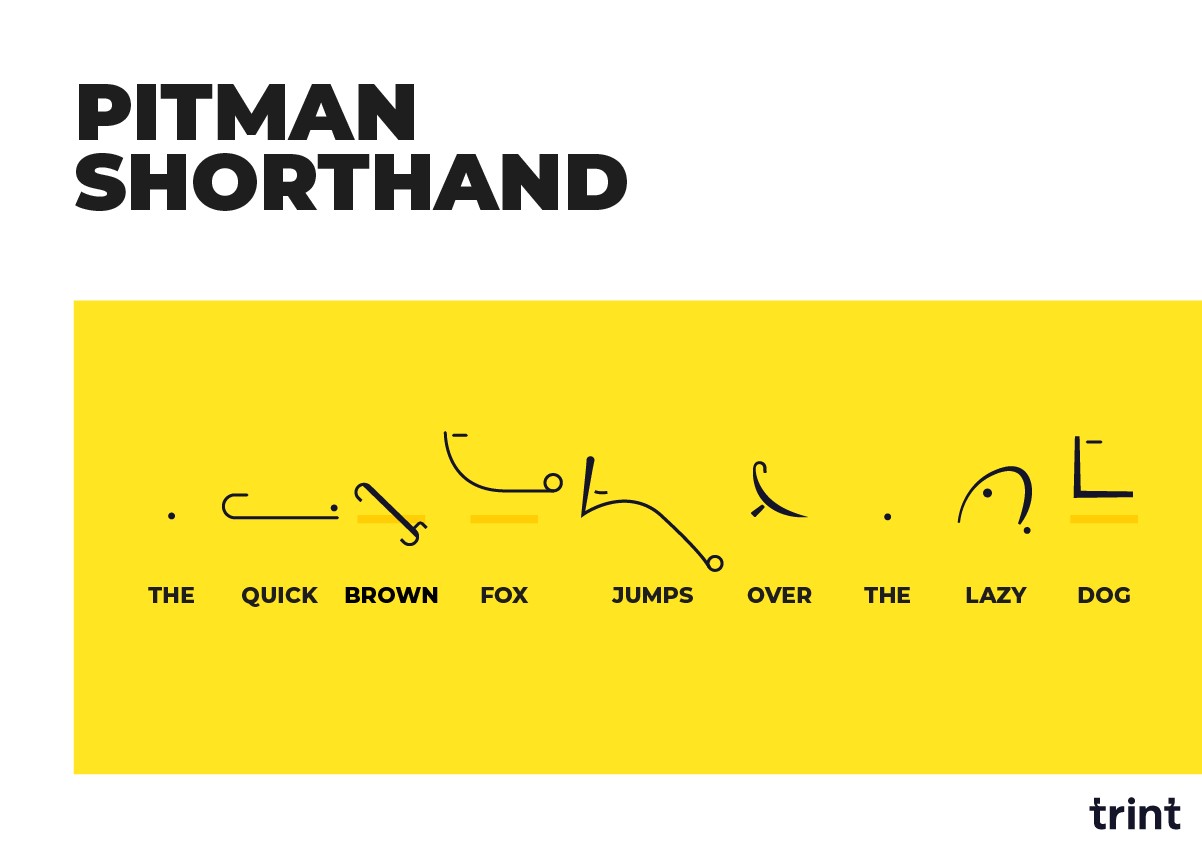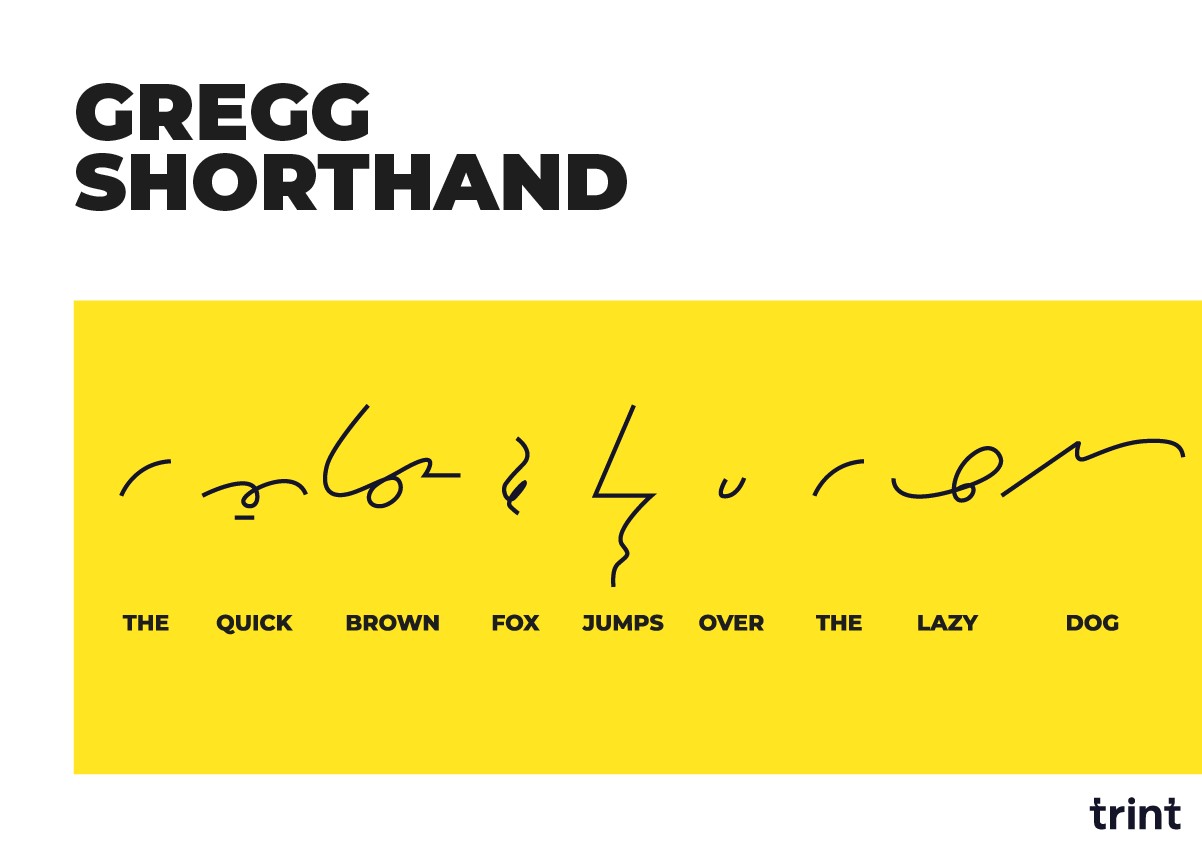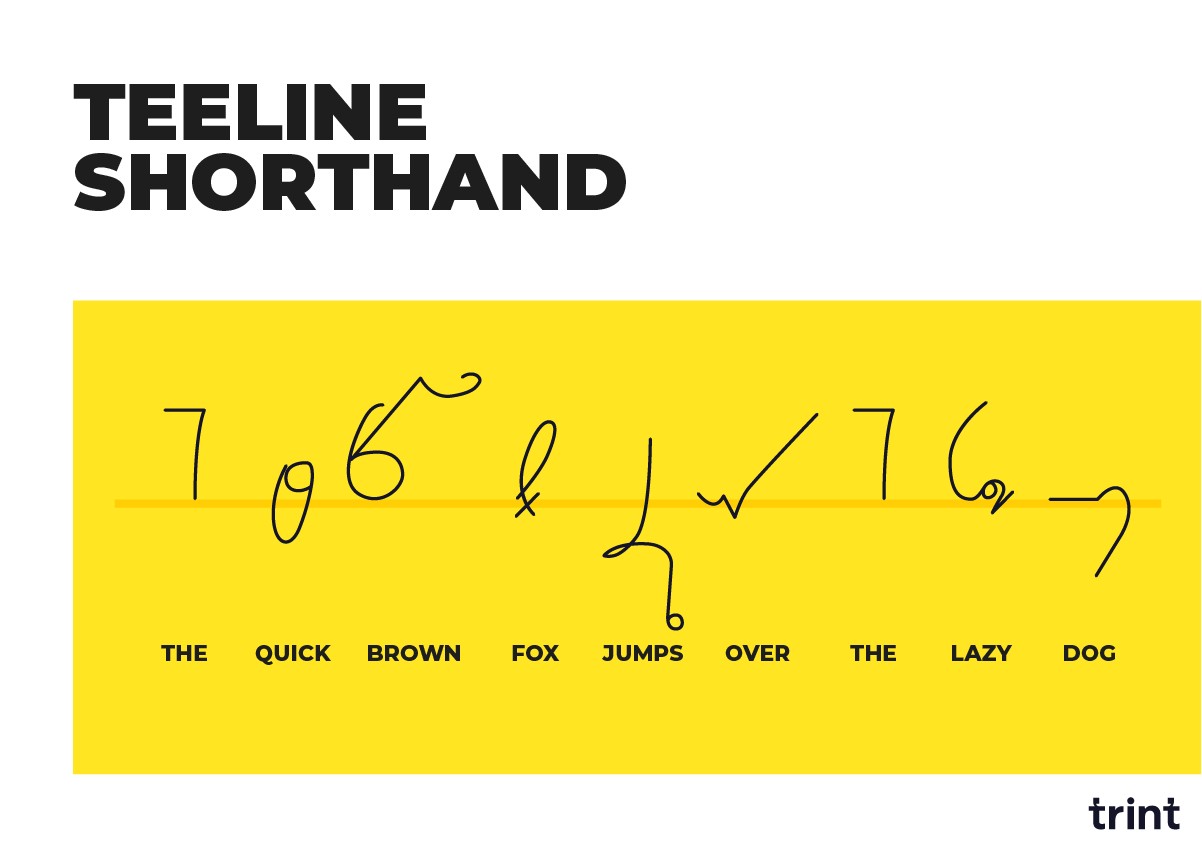Shorthand is a method of rapid writing that uses symbols and abbreviations to represent letters, words, and phrases quickly. At WHAT.EDU.VN, we understand your need for quick and reliable information; therefore, we provide comprehensive insights into shorthand, covering its history, different systems, and modern relevance. This guide will discuss the various shorthand techniques, from Gregg to Teeline, and highlight why this skill still holds value today, offering an alternative to transcription software, note-taking methods, and speech-to-text apps.
1. What Is Shorthand and Why Is It Important?
Shorthand is a system of abbreviated symbolic writing designed to increase the speed of writing compared to conventional methods. Shorthand techniques reduce the time it takes to capture information, making it ideal for scenarios where every word matters. Let’s delve deeper into why shorthand remains a significant skill.
- Speed and Efficiency: Shorthand enables writers to keep pace with fast speakers, capturing conversations, lectures, and meetings with remarkable speed.
- Historical Significance: Historically, shorthand was crucial for journalists, secretaries, and court reporters before the advent of modern recording technologies.
- Niche Applications Today: While technology offers alternatives, shorthand retains value in situations where digital tools are impractical or unavailable, such as in courtrooms or during interviews where recording devices are prohibited.
2. What Are the Main Types of Shorthand Systems?
Several shorthand systems have been developed over the years, each with unique rules and symbols. The most popular ones include Pitman, Gregg, and Teeline. Understanding the differences between these systems can help you choose the one that best fits your needs.
- Pitman Shorthand: Developed by Sir Isaac Pitman in 1837, this system focuses on phonetics, representing sounds rather than spellings.
- Thick and thin lines distinguish voiced and unvoiced consonants, adding a layer of precision.
- Vowel sounds are indicated by dots and dashes around the consonants.
- It’s renowned for accuracy but has a steep learning curve, making it suitable for professional stenographers.
- Gregg Shorthand: Created by John Robert Gregg in 1888, this system uses simple, cursive-like symbols, emphasizing fluidity and speed.
- It eliminates the need for varying line thickness, making it easier to write quickly.
- Line length indicates sounds.
- Common among secretaries and journalists, especially in the United States, it offers a balance between speed and readability.
- Teeline Shorthand: Developed by James Hill in 1968, Teeline simplifies letters and spells longer words phonetically, omitting vowels and unnecessary sounds.
- It is alphabet-based.
- It is easy to learn and customize with personal abbreviations.
- Popular among journalists and students, particularly in the UK, Teeline is accepted by the National Council for the Training of Journalists (NCTJ).
3. What Are the Pros and Cons of Each Shorthand System?
Each shorthand system has advantages and disadvantages. Choosing the right one depends on your needs and learning style.
| System | Pros | Cons |
|---|---|---|
| Pitman | Extremely fast, distinguishes symbols clearly with line thickness, renowned for accuracy. | Requires a special pen, steep learning curve, less flexible. |
| Gregg | Smooth, cursive-like style, easy to read back if fluent, flexible for personal note-taking. | Can have a steep learning curve, not as widely taught as Teeline, requires sustained practice. |
| Teeline | Simplified structure, easier to learn than Pitman or Gregg, requires no special pens, adaptable with personalized abbreviations. | Slower than Pitman or Gregg for advanced users, less emphasis on phonetics. |



4. How Does Pitman Shorthand Work?
Pitman shorthand uses a phonetic approach, where symbols represent sounds instead of letters. This system relies on varying the thickness of lines to distinguish between voiced and unvoiced consonants.
- Voiced vs. Unvoiced Consonants: Thick lines represent voiced consonants like “b” or “d,” while thin lines represent unvoiced consonants like “p” or “t.”
- Vowel Representation: Vowel sounds are indicated by dots and dashes placed around the consonants, adding another layer of detail to the transcription.
- Speed and Accuracy: Its precision makes it ideal for verbatim transcription. Mastering Pitman requires dedication, but the speed and accuracy it offers are unmatched.
5. How Does Gregg Shorthand Work?
Gregg shorthand offers a more fluid, cursive-like approach. Unlike Pitman, it eliminates the need for thick and thin lines, using line length to denote sounds.
- Cursive-Like Symbols: Its symbols flow smoothly, reducing the need to lift the pen frequently, which enhances writing speed.
- Phonetic Basis: Though phonetic-based, Gregg uses line length to differentiate sounds. For example, the line for T is half as long as the line for D.
- Versatility: Gregg is favored by journalists and secretaries for its balance between speed and readability. Its adaptability makes it suitable for both personal and professional use.
6. How Does Teeline Shorthand Work?
Teeline shorthand simplifies the alphabet, making it easier to learn and use. This system spells longer words phonetically, often omitting vowels and unnecessary sounds to accelerate the writing process.
- Alphabet-Based System: This makes it more intuitive for beginners.
- Phonetic Spelling: Teeline shortens words phonetically, such as turning “journalist” into “jnl-ist,” to increase speed.
- Customization: Users can create personalized abbreviations. This flexibility is a significant advantage. Teeline is popular among journalists and students.
7. What Are the Key Differences Between Pitman, Gregg, and Teeline?
Understanding the key differences between Pitman, Gregg, and Teeline can help you determine which system aligns best with your learning style and professional needs.
| Feature | Pitman | Gregg | Teeline |
|---|---|---|---|
| Line Thickness | Uses thick and thin lines to distinguish sounds. | Eliminates varying line thickness. | Does not use varying line thickness. |
| Symbol Style | Uses distinct symbols for each sound. | Uses simple, cursive-like symbols. | Simplifies letters from the alphabet. |
| Phonetic Emphasis | Strong emphasis on phonetic accuracy. | Emphasizes fluidity and speed while maintaining phonetic accuracy. | Focuses on simplified, phonetic spelling. |
| Learning Curve | Steep learning curve due to complex rules and symbols. | Moderate learning curve, balancing complexity and ease of use. | Easier to learn due to its simplified structure and alphabet-based approach. |
| Best Suited For | Professional stenographers requiring maximum accuracy and speed. | Journalists and secretaries needing a balance of speed and readability. | Journalists and students needing a quick, customizable system. |
8. Is Shorthand Still Relevant in the Age of Digital Transcription?
While digital tools have reduced reliance on shorthand, it remains a valuable skill in certain contexts. Shorthand offers advantages that technology cannot replicate.
- Tech-Free Zones: Shorthand is invaluable in environments where electronic devices are prohibited.
- Equipment Malfunctions: It serves as a reliable backup during technical failures.
- Professional Edge: Learning shorthand can distinguish you in competitive fields like journalism and court reporting.
- Speed and Precision: Shorthand enables unparalleled speed and precision in documenting proceedings, making it indispensable for court stenographers and parliamentary reporters.
9. How Can Shorthand Give You a Professional Edge in Journalism?
In journalism, shorthand remains a valuable asset. It allows reporters to capture quotes accurately during interviews and court sessions, especially when recording devices are not an option.
- Accuracy: Shorthand ensures that quotes are captured verbatim.
- Speed: It enables journalists to keep pace with fast-paced conversations.
- Versatility: It provides a reliable alternative when technology is unavailable or restricted.
10. How Can You Learn Shorthand Effectively?
Learning shorthand requires a structured approach and consistent practice. Here are the key steps to learn shorthand effectively:
- Choose Your System: Select a system that aligns with your needs and learning style. Teeline is excellent for beginners due to its simplicity, while Gregg offers a balance between speed and readability. Pitman is ideal for advanced users seeking maximum speed.
- Learn the Basics: Start with the alphabet and basic symbols. Mastering these building blocks is crucial before moving on to more complex phrases.
- Practice Common Words and Phrases: Focus on frequently used words and phrases. Shorthand systems often include shortcuts for common terms. Repeating these helps build speed and confidence.
- Practice Regularly: Consistency is critical. Dedicate at least 15–30 minutes a day to shorthand practice.
- Build Your Speed: Gradually increase your pace. Use dictation tools or recorded audio to practice transcribing in real-time.
- Join a Community: Find other learners online or in local groups to exchange tips and receive feedback. Sharing your journey can keep you motivated.
11. What Are Some Effective Tips for Learning Teeline Shorthand?
Teeline is popular for its simplicity, making it a great starting point. Here are some effective tips for learning Teeline:
- Master Common Prefixes and Suffixes: These can dramatically increase your speed and efficiency.
- Create a Cheat Sheet: Write down abbreviations for commonly used words and phrases to have them readily available.
12. What Are Some Effective Tips for Learning Gregg Shorthand?
Gregg offers a balance between speed and readability. Here are some tips to help you master Gregg:
- Focus on Fluidity: Practice smooth, flowing strokes rather than lifting your pen frequently.
- Learn the Phonetic System: Understanding how Gregg uses sounds instead of letters is key to mastering it.
13. What Are Some Effective Tips for Learning Pitman Shorthand?
Pitman is known for its accuracy and speed, but it requires a dedicated approach. Here are some tips to help you succeed with Pitman:
- Invest in the Right Tools: Use a pencil or pen capable of creating thin and thick lines, as they are essential to Pitman.
- Learn the Placement Rules: Pitman uses positioning to differentiate between similar-sounding words, so this is crucial.
- Practice Vowel Markings: Though often skipped for speed, knowing when to include vowels improves accuracy.
14. Where Can You Find Resources to Learn Shorthand?
Many resources are available to help you learn shorthand, including online courses, textbooks, and communities.
- Online Courses: Platforms like Udemy and Coursera offer courses on various shorthand systems.
- Textbooks: Books such as “Pitman Shorthand Instructor and Key” and “Gregg Shorthand Manual Simplified” provide comprehensive lessons.
- Online Communities: Websites like Reddit and shorthand-specific forums allow you to connect with other learners, ask questions, and share resources.
15. What Role Does Practice Play in Mastering Shorthand?
Practice is the cornerstone of mastering shorthand. Consistent, focused practice helps you internalize the symbols, rules, and techniques necessary for fast, accurate writing.
- Consistency: Regular practice sessions, even if short, are more effective than sporadic, longer sessions.
- Real-Life Scenarios: Apply shorthand to everyday tasks such as note-taking, journaling, or summarizing conversations.
- Dictation Exercises: Use dictation tools or recorded audio to practice transcribing in real-time.
16. How Can Shorthand Be Useful in Modern Professions Besides Journalism?
While journalism is a traditional field for shorthand, its applications extend to various modern professions.
- Legal Professionals: Court reporters and legal assistants use shorthand to document court proceedings, depositions, and client meetings.
- Administrative Assistants: Shorthand helps administrative assistants take quick notes during meetings, phone calls, and dictation sessions.
- Researchers: Researchers can use shorthand to record observations, interviews, and field notes efficiently.
17. What Are the Best Tools to Use for Practicing Shorthand?
Having the right tools can enhance your shorthand practice.
- Pencils and Pens: For Pitman, use a pen or pencil capable of producing varying line thicknesses. For Gregg and Teeline, any comfortable writing tool will suffice.
- Notebooks: Choose notebooks with smooth paper to facilitate fluid writing.
- Dictation Software: Software like Dragon NaturallySpeaking can be used to practice transcribing spoken words in real-time.
- Online Resources: Websites and apps that provide dictation exercises, practice materials, and community forums.
18. What Are Some Common Mistakes to Avoid When Learning Shorthand?
Avoiding common mistakes can streamline your shorthand learning process.
- Neglecting the Basics: Ensure a solid foundation in the alphabet and basic symbols before moving on to more complex material.
- Inconsistent Practice: Regular practice is essential. Avoid long gaps between practice sessions.
- Ignoring Accuracy: Focus on accuracy before speed. Speed will come with practice.
- Not Customizing: Adapt the system to your needs. Create personalized abbreviations.
19. How Does Shorthand Compare to Modern Speech-to-Text Software?
Shorthand and speech-to-text software both aim to capture spoken words quickly, but they differ in several key aspects.
- Accuracy: Modern speech-to-text software has improved significantly but can still struggle with accents, background noise, and complex terminology. Shorthand, when mastered, offers high accuracy.
- Reliability: Shorthand does not rely on technology, making it a reliable option in situations where devices are unavailable or prone to failure.
- Privacy: Shorthand offers greater privacy. No need to worry about recording or storing sensitive information on devices.
- Cost: Speech-to-text software often involves subscription fees or hardware costs, while shorthand requires minimal investment in tools.
20. What Future Innovations Could Enhance Shorthand Techniques?
While shorthand is a traditional skill, future innovations could enhance its techniques.
- Digital Shorthand: Developing digital shorthand systems that combine the speed of shorthand with the convenience of digital devices.
- AI-Assisted Learning: Using AI to provide personalized feedback, track progress, and generate customized practice exercises.
- Hybrid Systems: Combining shorthand with speech-to-text technology to create hybrid systems that leverage the strengths of both.
Shorthand is a powerful tool for anyone needing to capture information quickly and accurately. Whether you are a journalist, student, or professional, mastering shorthand can give you a significant advantage. At WHAT.EDU.VN, we provide comprehensive resources to help you explore and learn various shorthand systems.
Do you have questions about shorthand or any other topic? Visit WHAT.EDU.VN today and ask your question for free. Our community of experts is ready to provide accurate and helpful answers. Don’t struggle with unanswered questions—get the insights you need at what.edu.vn.
Our address is 888 Question City Plaza, Seattle, WA 98101, United States. You can also reach us via Whatsapp at +1 (206) 555-7890. We look forward to helping you find the answers you need!